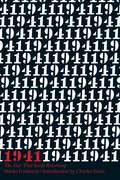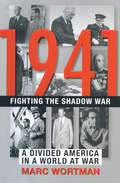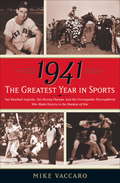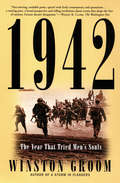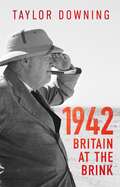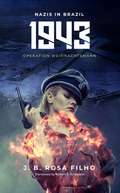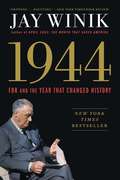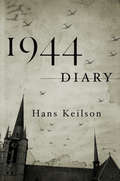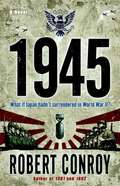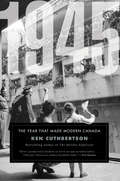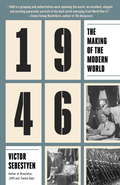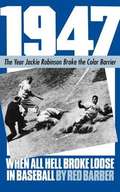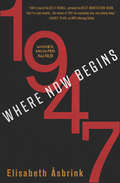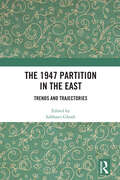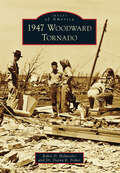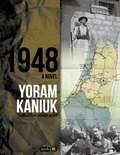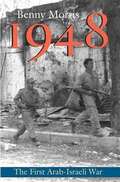- Table View
- List View
1941: The Year Germany Lost the War
by Andrew NagorskiBestselling historian Andrew Nagorski &“brings keen psychological insights into the world leaders involved&” (Booklist) during 1941, the critical year in World War II when Hitler&’s miscalculations and policy of terror propelled Churchill, FDR, and Stalin into a powerful new alliance that defeated Nazi Germany. In early 1941, Hitler&’s armies ruled most of Europe. Churchill&’s Britain was an isolated holdout against the Nazi tide, but German bombers were attacking its cities and German U-boats were attacking its ships. Stalin was observing the terms of the Nazi-Soviet Pact, and Roosevelt was vowing to keep the United States out of the war. Hitler was confident that his aim of total victory was within reach. But by the end of 1941, all that changed. Hitler had repeatedly gambled on escalation and lost: by invading the Soviet Union and committing a series of disastrous military blunders; by making mass murder and terror his weapons of choice, and by rushing to declare war on the United States after Japan&’s attack on Pearl Harbor. Britain emerged with two powerful new allies—Russia and the United States. By then, Germany was doomed to defeat. Nagorski illuminates the actions of the major characters of this pivotal year as never before. 1941: The Year Germany Lost the War is a stunning and &“entertaining&” (The Wall Street Journal) examination of unbridled megalomania versus determined leadership. It also reveals how 1941 set the Holocaust in motion, and presaged the postwar division of Europe, triggering the Cold War. 1941 was &“the year that shaped not only the conflict of the hour but the course of our lives—even now&” (New York Times bestselling author Jon Meacham).
1941: The Year That Keeps Returning
by Charles Simic Michael Gable Slavko GoldsteinA New York Review Books OriginalThe distinguished Croatian journalist and publisher Slavko Goldstein says, "Writing this book about my family, I have tried not to separate what happened to us from the fates of many other people and of an entire country." 1941: The Year That Keeps Returning is Goldstein's astonishing historical memoir of that fateful year--when the Ustasha, the pro-fascist nationalists, were brought to power in Croatia by the Nazi occupiers of Yugoslavia. On April 10, when the German troops marched into Zagreb, the Croatian capital, they were greeted as liberators by the Croats. Three days later, Ante Pavelić, the future leader of the Independent State of Croatia, returned from exile in Italy and Goldstein's father, the proprietor of a leftist bookstore in Karlovac--a beautiful old city fifty miles from the capital--was arrested along with other local Serbs, communists, and Yugoslav sympathizers. Goldstein was only thirteen years old, and he would never see his father again. More than fifty years later, Goldstein seeks to piece together the facts of his father's last days. The moving narrative threads stories of family, friends, and other ordinary people who lived through those dark times together with personal memories and an impressive depth of carefully researched historic details. The other central figure in Goldstein's heartrending tale is his mother--a strong, resourceful woman who understands how to act decisively in a time of terror in order to keep her family alive. From 1941 through 1945 some 32,000 Jews, 40,000 Gypsies, and 350,000 Serbs were slaughtered in Croatia. It is a period in history that is often forgotten, purged, or erased from the history books, which makes Goldstein's vivid, carefully balanced account so important for us today--for the same atrocities returned to Croatia and Bosnia in the 1990s. And yet Goldstein's story isn't confined by geographical boundaries as it speaks to the dangers and madness of ethnic hatred all over the world and the urgent need for mutual understanding.
1941: Fighting the Shadow War: A Divided America in a World at War
by Marc WortmanIn 1941: Fighting the Shadow War, A Divided America in a World at War, historian Marc Wortman thrillingly explores the little-known history of America’s clandestine involvement in World War II before the attack on Pearl Harbor.Prior to that infamous day, America had long been involved in a shadow war. Winston Churchill, England’s beleaguered new Prime Minister, pleaded with Franklin D. Roosevelt for help. FDR concocted ingenious ways to come to his aid, without breaking the Neutrality Acts. Launching Lend-Lease, conducting espionage at home and in South America to root out Nazi sympathizers, and waging undeclared war in the Atlantic, were just some of the tactics with which FDR battled Hitler in the shadows.FDR also had to contend with growing isolationism and anti-Semitism as he tried to influence public opinion. While Americans were sympathetic to those being crushed under Axis power, they were unwilling to enter a foreign war. Wortman tells the story through the eyes of the powerful as well as ordinary citizens. Their stories weave throughout the intricate tapestry of events that unfold during the crucial year of 1941.Combining military and political history, Wortman tells the eye-opening story of how FDR took the country to war.
1941 -- The Greatest Year In Sports
by Mike VaccaroJoe DiMaggio . . . Ted Williams . . . Joe Louis . . . Billy Conn . . . WhirlawayAgainst the backdrop of a war that threatened to consume the world, these athletes transformed 1941 into one of the most thrilling years in sports history.In the summer of 1941, America paid attention to sports with an intensity that had never been seen before. World War II was raging in Europe and headlines grew worse by the day; even the most optimistic people began to accept the inevitability of the United States being drawn into the conflict. In sports pages and arenas at home, however, an athletic perfect storm provided unexpected--and uplifting--relief. Four phenomenal sporting events were underway, each destined to become legend.In 1941--The Greatest Year in Sports, acclaimed sportswriter Mike Vaccaro chronicles this astounding moment in history. Fueled by a somber mania for sports--a desire for good news to drown out the bad--Americans by the millions fervently watched, listened, and read as Joe DiMaggio dazzled the country by hitting in a record-setting fifty-six consecutive games; Ted Williams powered through an unprecedented .406 season; Joe Louis and Billy Conn (the heavyweight and light-heavyweight champions) battled in unheard-of fashion for boxing's ultimate championship; and the phenomenal (some say deranged) thoroughbred, Whirlaway, raced to three heart-stopping victories that won the coveted Triple Crown of horse racing. As Phil Rizzuto perfectly expressed, "You read the sports section a lot because you were afraid of what you'd see in other parts of the paper."Gripping and nostalgic, 1941--The Greatest Year in Sports focuses on these four seminal events and brings to life the national excitement and remarkable achievement (many of these records still stand today), as well as the vibrant lives of the athletes who captivated the nation. With vast insight, Vaccaro pulls back the veil on DiMaggio's anxieties and the building pressure of "The Streak," and chronicles the brash, young confidence Williams displayed as he hammered his way through the baseball season largely in DiMaggio's shadow. He takes readers inside the head of Billy Conn, a kid who traded in his light-heavyweight belt for a shot at the very decent and very powerful Joe Louis, and tells the story of the fire-breathing racehorse, Whirlaway, who was known either for setting track records or tearing off in the wrong direction. Rich in historical detail and edge-of-your-seat reporting, Mike Vaccaro has crafted a lasting, important book that captures a portrait of one of America's most trying, and extraordinary, eras.From the Trade Paperback edition.
1942: A Novel
by Robert ConroyDecember 7 is "the date which will live in infamy." But now Japan is hatching another, far greater plan to bring America to its knees. . . . The Japanese surprise attack on Pearl Harbor was a resounding success-except for one detail: a second bombing mission, to destroy crucial oil storage facilities, was aborted that day. Now, in this gripping and stunning work of alternate history, Robert Conroy reimagines December 7, 1941, to include the attack the Japanese didn't launch, and what follows is a thrilling tale of war, resistance, sacrifice, and courage. For when Admiral Isoroku Yamamoto sees how badly the United States has been ravaged in a two-pronged strike, he devises another, more daring proposal: an all-out invasion of Hawaii to put a stranglehold on the American Pacific Fleet. Yamamoto's strategy works brilliantly-at first. But a handful of American soldiers and a determined civilian resistance fight back in the face of cruelty unknown in Western warfare. Stateside, a counterassault is planned-and the pioneering MIT-trained aviator Colonel Jimmy Doolittle is given a near-impossible mission with a fleet of seaplanes jury-rigged into bombers. From spies to ordinary heroes and those caught between two cultures at war, this is the epic saga of the Battle of Hawaii-the way it very nearly was. . . .
1942: Winston Churchill and Britain's Darkest Hour
by Taylor DowningA revelatory new work of popular history focused on the year 1942, as the fate of Britain—and Winston Churchill&’s leadership—hangs in the balance.Eighty years ago, Britain stood at the brink of defeat. In 1942, a string of military disasters engulfed Britain in rapid succession : the collapse in Malaya; the biggest surrender in British history at Singapore; the passing of three large German warships through the Straits of Dover in broad daylight; the longest ever retreat through Burma to the gates of India; serious losses to Rommel's forces in North Africa; the siege of Malta and the surrender at Tobruk. All of this occurred against the backdrop of catastrophic sinkings in the Atlantic and the Arctic convoys. People began to claim that Churchill was not up to the job and his leadership was failing badly. Public morale reached a new low. Taylor Downing&’s 1942 explores the story of frustration and despair of that year, prompting Winston Churchill to demand of his army chief, "Have you not got a single general who can win battles?&” Using newly discovered archival material, historian Taylor Downing shows just how unpopular Churchill became in 1942, with two votes attacking his leadership in the House of Commons and the emergence of a serious political rival.Some argue that Britain's most precarious moment of the war was in 1940—when the nation stood up against the threat of German invasion during the Battle of Britain. But in 1942, Taylor Downing describes, in nail-biting detail, what was really Britain's darkest hour of World War II.
1942: The Year That Tried Men's Souls
by Winston GroomAmerica’s first year in World War II, chronicled in this “page-turner” by the Pulitzer Prize–nominated author of Forrest Gump and The Generals (Publishers Weekly). On December 7, 1941, an unexpected attack on American territory pulled an unprepared country into a terrifying new brand of warfare. To the generation of Americans who lived through it, the Second World War was the defining event of the twentieth century, and the defining moments of that war were played out in the year 1942. This account covers the Allies’ relentless defeats as the Axis overran most of Europe, North Africa, and the Far East. But by midyear the tide began to turn. The United States finally went on the offensive in the Pacific. In the West, the British defeated Rommel’s panzer divisions at El Alamein while the US Army began to push the Germans out of North Africa. By the year’s end, the smell of victory was in the air. 1942, told with Winston Groom’s accomplished storyteller’s eye, allows us into the admirals’ strategy rooms, onto the battlefronts, and into the heart of a nation at war. “When not drawing in readers with the narrative, Groom is impressing them with his masterful analyses.” —The Atlanta Journal-Constitution “Groom has done an artful job of blending the many stories of 1942.” —The Anniston Star
1942: Britain at the Brink
by Taylor Downing'Taylor Downing vividly brings to life a terrible year' Max Hastings Sunday TimesEighty years ago, Britain stood at the brink of defeat. In 1942, a string of military disasters engulfed Britain in rapid succession : the collapse in Malaya; the biggest surrender in British history at Singapore; the passing of three large German warships through the Straits of Dover in broad daylight; the longest ever retreat through Burma to the gates of India; serious losses to Rommel's forces in North Africa; the siege of Malta and the surrender at Tobruk. All of this occurred against the backdrop of catastrophic sinkings in the Atlantic and the Arctic convoys. People began to claim that Churchill was not up to the job and his leadership was failing badly. Public morale reached a new low. 1942 Britain At the Brink explores the story of frustration and despair in that year prompting the Prime Minister to demand of his army chief 'Have you not got a single general who can win battles?' Using new archival material, historian Taylor Downing shows just how unpopular Churchill became in 1942 with two votes attacking his leadership in the Commons and the emergence of a serious political rival. Most people think that Britain's worst moment of the war was in 1940 when the nation stood up against the threat of German invasion. In 1942 Britain at the Brink, Taylor Downing describes in nail-biting detail what was really Britain's darkest hour .
1942: Britain at the Brink
by Taylor Downing'Taylor Downing vividly brings to life a terrible year' Max Hastings Sunday TimesEighty years ago, Britain stood at the brink of defeat. In 1942, a string of military disasters engulfed Britain in rapid succession : the collapse in Malaya; the biggest surrender in British history at Singapore; the passing of three large German warships through the Straits of Dover in broad daylight; the longest ever retreat through Burma to the gates of India; serious losses to Rommel's forces in North Africa; the siege of Malta and the surrender at Tobruk. All of this occurred against the backdrop of catastrophic sinkings in the Atlantic and the Arctic convoys. People began to claim that Churchill was not up to the job and his leadership was failing badly. Public morale reached a new low. 1942 Britain At the Brink explores the story of frustration and despair in that year prompting the Prime Minister to demand of his army chief 'Have you not got a single general who can win battles?' Using new archival material, historian Taylor Downing shows just how unpopular Churchill became in 1942 with two votes attacking his leadership in the Commons and the emergence of a serious political rival. Most people think that Britain's worst moment of the war was in 1940 when the nation stood up against the threat of German invasion. In 1942 Britain at the Brink, Taylor Downing describes in nail-biting detail what was really Britain's darkest hour .
1942: Britain at the Brink
by Taylor Downing'Taylor Downing vividly brings to life a terrible year' Max Hastings, Sunday Times'Taylor Downing is a wonderful historian and a wonderful history communicator.' Dan Snow, History HitEighty years ago, Britain stood at the brink of defeat. In 1942, a string of military disasters engulfed Britain in rapid succession : the collapse in Malaya; the biggest surrender in British history at Singapore; the passing of three large German warships through the Straits of Dover in broad daylight; the longest ever retreat through Burma to the gates of India; serious losses to Rommel's forces in North Africa; the siege of Malta and the surrender at Tobruk. All of this occurred against the backdrop of catastrophic sinkings in the Atlantic and the Arctic convoys. People began to claim that Churchill was not up to the job and his leadership was failing badly. Public morale reached a new low. 1942 Britain At the Brink explores the story of frustration and despair in that year prompting the Prime Minister to demand of his army chief 'Have you not got a single general who can win battles?' Using new archival material, historian Taylor Downing shows just how unpopular Churchill became in 1942 with two votes attacking his leadership in the Commons and the emergence of a serious political rival. Most people think that Britain's worst moment of the war was in 1940 when the nation stood up against the threat of German invasion. In 1942 Britain at the Brink, Taylor Downing describes in nail-biting detail what was really Britain's darkest hour .
1943 -- Operation Weihnachtsmann: Nazis in Brazil
by Jb Rosa FilhoSuspenseful novel about attempts of Nazi Abwehr agent to subvert Brazil's valiant efforts in support of the Allied war effort during World War Two -- a little known and much neglected theater of that critically important event.
1944
by Jay WinikNew York Times bestselling author Jay Winik brings to life in gripping detail the year 1944, which determined the outcome of World War II and put more pressure than any other on an ailing yet determined President Roosevelt.It was not inevitable that World War II would end as it did, or that it would even end well. 1944 was a year that could have stymied the Allies and cemented Hitler's waning power. Instead, it saved those democracies--but with a fateful cost. Now, in a superbly told story, Jay Winik, the acclaimed author of April 1865 and The Great Upheaval, captures the epic images and extraordinary history as never before. 1944 witnessed a series of titanic events: FDR at the pinnacle of his wartime leadership as well as his reelection, the planning of Operation Overlord with Churchill and Stalin, the unprecedented D-Day invasion, the liberation of Paris and the horrific Battle of the Bulge, and the tumultuous conferences that finally shaped the coming peace. But on the way, millions of more lives were still at stake as President Roosevelt was exposed to mounting evidence of the most grotesque crime in history, the Final Solution. Just as the Allies were landing in Normandy, the Nazis were accelerating the killing of millions of European Jews. Winik shows how escalating pressures fell on an all but dying Roosevelt, whose rapidly deteriorating health was a closely guarded secret. Here then, as with D-Day, was a momentous decision for the president. Was winning the war the best way to rescue the Jews? Was a rescue even possible? Or would it get in the way of defeating Hitler? In a year when even the most audacious undertakings were within the world's reach, including the liberation of Europe, one challenge--saving Europe's Jews--seemed to remain beyond Roosevelt's grasp. As he did so brilliantly in April 1865, Winik provides a stunningly fresh look at the twentieth century's most pivotal year. Magisterial, bold, and exquisitely rendered, 1944: FDR and the Year that Changed History is the first book to tell these events with such moral clarity and unprecedented sweep, and a moving appreciation of the extraordinary struggles of the era's outsized figures. 1944 is destined to take its place as one of the great works of World War II.
1944 Diary
by Damion Searls Hans Keilson[1944 Diary] is a deeply personal account, made even more remarkable that it was written during World War II and the horrors of the Holocaust . . . A moving and fascinating read." —Library JournalIn 2010, FSG published two novels by the German- Jewish writer Hans Keilson: Comedy in a Minor Key—written in 1944 while Keilson was in hiding in the Netherlands, first published in German in 1947, and never before in English—and The Death of the Adversary, begun in 1944 and published in 1959, also in German. With their Chekhovian sympathy for perpetrators and bystanders as well as for victims and resisters, Keilson’s novels were, as Francine Prose said on the front page of The New York Times Book Review, “masterpieces” by “a genius” on her list of “the world’s very greatest writers.” Keilson was one hundred years old, alive and well and able to enjoy his belated fame.1944 Diary, rediscovered among Keilson’s papers shortly after his death, covers nine months he spent in hiding in Delft with members of a Dutch resistance group, having an affair with a younger Jewish woman in hiding a few blocks away and striving to make a moral and artistic life for himself as the war and the Holocaust raged around him. For readers familiar with Keilson’s novels as well as those new to his work, this diary is an incomparable spiritual X-ray of the mind and heart behind the art: a record of survival and creativity in what Keilson called “the most critical year of my life.”Offering further insight into Keilson are the sonnets he wrote for his lover, Hanna Sanders, which appear in translation at the back of this volume.
1945: A Novel
by Robert ConroyAmerica has dropped atomic bombs on Hiroshima and Nagasaki.But Japan has only begun to fight. . . .In 1945, history has reached a turning point. A terrible new weapon has been unleashed. Japan has no choice but to surrender. But instead, the unthinkable occurs. With their nation burned and shattered, Japanese fanatics set in motion a horrifying endgame-their aim: to take America down with them. In Robert Conroy's brilliantly imagined epic tale of World War II, Emperor Hirohito's capitulation is hijacked by extremists and a weary United States is forced to invade Japan as a last step in a war that has already cost so many lives. As the Japanese lash out with tactics that no one has ever faced before-from POWs used as human shields to a rain of kamikaze attacks that take out the highest-value target in the Pacific command-the invasion's success is suddenly in doubt. As America's streets erupt in rioting, history will turn on the acts of a few key players from the fiery front lines to the halls of Washington to the shadowy realm of espionage, while a mortally wounded enemy becomes the greatest danger of all.
1945: The Year That Made Modern Canada
by Ken CuthbertsonIt was a watershed year for Canada and the world. 1945 set Canada on a bold course into the future. A huge sense of relief marked the end of hostilities. Yet there was also fear and uncertainty about the perilous new world that was unfolding in the wake of the American decision to use the atomic bomb to bring the war in the Pacific to a dramatic halt. On the eve of WWII, the Dominion of Canada was a sleepy backwater still struggling to escape the despair of the Great Depression. But the war changed everything. After six long years of conflict, sacrifice and soul-searching, the country emerged onto the world stage as a modern, confident and truly independent nation no longer under the colonial sway of Great Britain. Ken Cuthbertson has written a highly readable narrative that commemorates the seventy-fifth anniversary of the end of WWII and chronicles the events and personalities of a critical year that reshaped Canada. 1945: The Year That Made Modern Canada showcases the stories of people—some celebrated, some ordinary—who left their mark on the nation and helped create the Canada of today. The author profiles an eclectic group of Canadians, including eccentric prime minister Mackenzie King, iconic hockey superstar Rocket Richard, business tycoon E. P. Taylor, Soviet defector Igor Gouzenko, the bandits of the Polka Dot Gang, crusading MP Agnes Macphail, and authors Gabrielle Roy and Hugh MacLennan, among many others. The book also covers topics like the Halifax riots, war brides, the birth of Canada’s beloved social safety net, and the remarkable events that sparked the Cold War. 1945 is the unforgettable story of our nation at the moment of its modern birth.
1946: The Making of the Modern World
by Victor SebestyenFrom the author of Twelve Days: The Story of the 1956 Hungarian Revolution and Revolution 1989: The Fall of the Soviet Empire comes a powerful, revelatory book about the year that would signal the beginning of the Cold War, the end of the British Empire, and the beginning of the rivalry between the United States and the USSR. Victor Sebestyen reveals the events of 1946 by chronologically framing what was taking place in Europe, the Middle East, and Asia, with seminal decisions made by heads of state that would profoundly change the old order forever. Whether it was the July 22 bombing of the King David Hotel in Jerusalem, the July 25 Bikini Atoll underwater atomic bomb test, or the August 16 Great Calcutta Killings in India, 1946 was a year of seismic and dramatic events. Sebestyen begins with the Moscow Foreign Ministers' Conference the week before Christmas 1945, when Stalin announced that the USSR would not withdraw its troops from Iran by March 1946, and ends with the morning of November 3, 1946, when Emperor Hirohito officially unveiled Japan's new constitution before the National Diet. The year 1946 would see the map of Eastern Europe redrawn, Chinese communists gaining decisive victories in their fight for power, and the birth of Israel. Though Truman, Stalin, Churchill, MacArthur, Ben-Gurion, Hirohito, and Menachem Begin are part of the story, Sebestyen also writes about the enormous suffering and ongoing persecution of civilians in the aftermath of the war: the pillaging and rape; the ethnic cleansing of the German population from Czechoslovakia and Poland; the rise of a violent new anti-Semitism; the civil wars in China and Greece; the mass starvation in Japan, Eastern Europe, and Germany on a scale not seen since the Middle Ages; the spread of diseases such as tuberculosis and diphtheria; and such total desolation that schools, government, and transportation were nonexistent and currency was worthless. Drawing on personal testimonies and new archival research, Sebestyen has written a vivid and compelling narrative that brilliantly evokes the beginning of the Cold War set against a devastated landscape of dystopian horrors.(With 16 pages of black-and-white photographs.)From the Hardcover edition.
1947: When All Hell Broke Loose in Baseball
by Red BarberThis is a great baseball story and an even better one about a crucial moment in American history. When Jackie Robinson was penciled into the lineup for the Brooklyn Dodgers in 1947, America's national pastime and America's future changed forever. How much is reflected in a remark Martin Luther King, Jr. made to Don Newcombe: "You'll never know what you and Jackie and Roy did to make it possible to do my job." Red Barber was perfectly situated to observe this drama. Broadcaster for the Dodgers, friend of Branch Rickey who confided in him before and during the year of decision, and keen student of the game and the behavior of its players, Red held the microphone as the story unfolded with a cast of characters that included baseball immortals Duke Snyder, Leo Durocher, Pee Wee Reese, Pete Reiser, Larry McPhail and Joe DiMaggio. Towering above them all are Jackie Robinson and Branch Rickey, who together made baseball and American history and whose courage and toughness Red Barber captures so beautifully in this book.
1947: Where Now Begins
by Fiona Graham Elisabeth ÅsbrinkAn award-winning writer captures a year that defined the modern world, intertwining historical events around the globe with key moments from her personal history.The year 1947 marks a turning point in the twentieth century. Peace with Germany becomes a tool to fortify the West against the threats of the Cold War. The CIA is created, Israel is about to be born, Simone de Beauvoir experiences the love of her life, an ill George Orwell is writing his last book, and Christian Dior creates the hyper-feminine New Look as women are forced out of jobs and back into the home. In the midst of it all, a ten-year-old Hungarian-Jewish boy resides in a refugee camp for children of parents murdered by the Nazis. This year he has to make the decision of a lifetime, one that will determine his own fate and that of his daughter yet to be born, Elisabeth.
1947 Ke Zakhma: १९४७ के ज़ख्म
by Rajeev Shuklaवर्ष 1947 में भारत-विभाजन के सात दशक से अधिक बीत जाने पर भी इस पीड़ा से गुजरे लोगों का दिलो-दिमाग आज भी इस दुःख का बोझ उठाए हुए है। नक्शे पर स्याही के बस एक निशान ने एक देश को दो में बाँट दिया, जिसका प्रभाव न केवल एक पीढ़ी पर, बल्कि आने वाली कई पीढि़यों पर भी पड़ा। इससे मिले ज़ख़्म आज भी अंदर तक पीड़ा देते हैं। भारत और पाकिस्तान को बाँटने वाली खौफनाक रेडक्लिफ रेखा के दोनों तरफ के लोगों ने अकल्पनीय त्रासदियों को झेला। लाखों लोगों के विस्थापन के कारण घटी भयानक घटनाएँ इस दुस्वप्न को भोग चुके लोगों की यादों को हमेशा कचोटती रहेंगी। हाँ, बड़े पैमाने पर बरबादी के बावजूद सब खो देने और सबकुछ गँवा बैठने के बीच उत्साहित करने वाली मानवीयता, साहस और दृढ़-संकल्प की कुछ कहानियाँ भी हैं। ये ऐसे लोगों की कहानियाँ हैं, जो प्रधानमंत्री, राष्ट्रपति, उद्योगपति, चिकित्सा-शोधार्थी तथा और भी बहुत-कुछ बने। विभाजन के बाद के दशकों में परिवारों की शून्य से शुरुआत कर फिर से जीवन-निर्माण करने की ये कहानियाँ याद रखने योग्य एवं प्रेरणादायी हैं। इन कहानियों में मनमोहन सिंह और मोहम्मद अली जिन्ना से लेकर गौरी खान की नानी और अवतार नारायण गुजराल तक आते हैं। ‘1947 के ज़ख़्म’ बीते समय की यात्रा का रोमांचक और भावुकतापूर्ण संकलन है। वह अविस्मरणीय समय था, जो दोनों देशों पर हमेशा के लिए निशान छोड़ गया।
The 1947 Partition in The East: Trends and Trajectories
by Subhasri GhoshThis book explores the experiences of people affected by the Partition of British India and princely states in 1947 through first-person accounts, memoirs, archival material, literature, and cinema. It focuses on the displacement, violence and trauma of the people affected and interrogates the interrelationships between nationalism, temporality, religion, and citizenship. The authors examine the mass migrations triggered by the 1947 Partition, amidst nationalist posturing, religious violence, and debates on crucial issues of refugee rehabilitation and redistribution of land and resources. It focuses on the drawing of the borders and the ruptures in the socio-cultural bonds within regions and communities brought on by demographic changes, violence, and displacement. The volume reflects on the significant mark left by the event on the socio-political sensibilities of various communities, and the questions of identity and citizenship. It also studies the effects of Partition on the politics of Bangladesh and India’s east and northeast states, specifically Bengal, Assam and Tripura. A significant addition to the existing corpus on Partition historiography, this book will be of interest to modern Indian history, partition studies, border studies, sociology, refugee and migration studies, cultural studies, literature, post-colonial studies and South Asian studies, particularly those concerned with Bengal, Northeast India and Bangladesh.
1947 Woodward Tornado (Images of America)
by Robin D. Hohweiler Dr. Deena FisherThe 1947 Woodward Tornado remains the deadliest tornado in Oklahoma history, leaving more than 100 people dead and nearly 1,000 seriously injured. The tornado struck the city of Woodward under cover of darkness and without warning at 8:42 p.m. on April 9, 1947. The storm left in its wake hundreds of stories of tragic loss, devastation, and even mysteries that remain unsolved. These include the three unidentified girls--one as young as six months--whose bodies have remained unclaimed, as well as the mystery of what happened to Joan Gay Croft, a girl who disappeared from the local hospital on the night of the storm. Croft's disappearance was featured in an episode of the television show Unsolved Mysteries in the early 1990s. There is also the oft-overlooked story of those who took up residence (some for more than a year) in "Tornado Town" west of the city and found some glimmer of hope in an otherwise hopeless situation.
1948
by Yoram Kaniuk Anthony BerrisSixty years after fighting in Israel's War of Independence, Yoram Kaniuk tries to remember what exactly did--and did not--happen in his time as a teenage soldier in the Palmach. The result is a touchingly poignant and hauntingly beautiful memoir that the author himself considers a work of fiction, for what is memory but one's own story about the past? Eschewing self-righteousness in favor of self-criticism, Kaniuk's book, winner of the 2010 Sapir Prize for Literature, is the tale of a younger man told by his older, wiser self--the self who realizes that wars are pointless, and that he and his friends, young men from good homes forming an offbeat band of brothers, were senseless to see glory in the prospect of dying young. But it is also a painful, shocking, and tragically relevant homage to the importance of bearing witness to the follies of the past, even--or especially--when they are one's own.
1948: A History Of The First Arab-israeli War
by Benny MorrisThis history of the foundational war in the Arab-Israeli conflict is groundbreaking, objective, and deeply revisionist. A riveting account of the military engagements, it also focuses on the war's political dimensions. Benny Morris probes the motives and aims of the protagonists on the basis of newly opened Israeli and Western documentation. The Arab side-where the archives are still closed-is illuminated with the help of intelligence and diplomatic materials. Morris stresses the jihadi character of the two-stage Arab assault on the Jewish community in Palestine. Throughout, he examines the dialectic between the war's military and political developments and highlights the military impetus in the creation of the refugee problem, which was a by-product of the disintegration of Palestinian Arab society. The book thoroughly investigates the role of the Great Powers-Britain, the United States, and the Soviet Union-in shaping the conflict and its tentative termination in 1949. Morris looks both at high politics and general staff decision-making processes and at the nitty-gritty of combat in the successive battles that resulted in the emergence of the State of Israel and the humiliation of the Arab world, a humiliation that underlies the continued Arab antagonism toward Israel.
1948: Harry Truman's Improbable Victory and the Year that Transformed America
by David PietruszaThe behind-the-headline true story of Harry Truman's stunning upset! Everyone knows the iconic news photo of jubilant underdog Harry Truman brandishing a copy of the Chicago Tribune proclaiming "DEWEY DEFEATS TRUMAN. " David Pietrusza goes backstage to explain how it happened, placing the brutal political battle in the context of an erupting Cold War and America's exploding storms over civil rights and domestic communism. Pietrusza achieves for 1948's presidential race what he previously did in his acclaimed 1960--LBJ vs. JFK vs. Nixon: bringing history to life and intrigue readers with tales of high drama while simultaneously presenting the issues, personalities, and controversies of this pivotal era with laser-like clarity.
1948: Harry Truman's Improbable Victory and the Year that Transformed America
by David PietruszaThe wild, combative inside story of the most stunning upset in the history of presidential elections—Harry Truman's victory over Tom Dewey: &“Outstanding.&”—Minneapolis Star-Tribune In this lively account, award-winning historian David Pietrusza unpacks the most ingloriously iconic headline in the history of presidential elections—DEWEY DEFEATS TRUMAN—to reveal the 1948 campaign's backstage events and recount the down-to-the-wire brawl fought against the background of an erupting Cold War, the Berlin Airlift, the birth of Israel, and a post-war America facing exploding storms over civil rights and domestic communism. &“Coherent, compelling…A skillful, authoritative investigation.&”—Kirkus Reviews &“A terrific book…a must-read.&”—Ron Faucheux, former editor-in-chief, Campaigns & Elections magazine &“Brilliantly portrays President Harry Truman's successful efforts to stave off the challenge of New York Gov. Tom Dewey, who was making a repeat bid as the Republican nominee.&”—David Mark, author of Going Dirty: The Art of Negative Campaigning &“Sweeping…compelling.&”—Library Journal &“Gripping detail.&”—The New York Journal of Books

